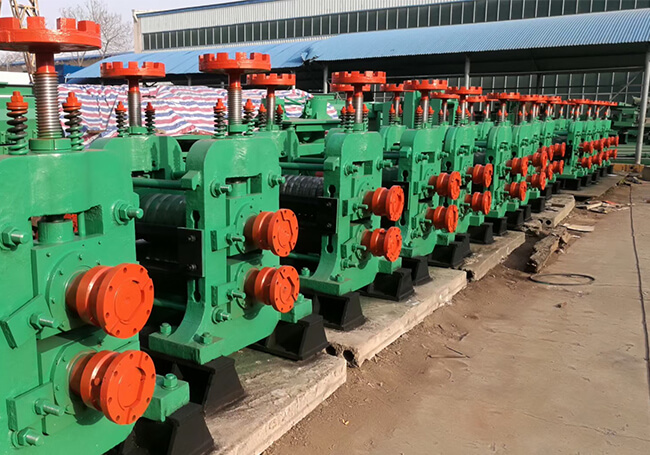The wire rod mill production line is used for rolling wire rods. The wire rod is the product with the smallest cross-sectional size of the profile. When it is rolled from the billet to the finished product, the total elongation coefficient is large, and the rolled piece is often only rolled once on each rolling mill. Therefore, the wire rod mill production line has the largest number of stands and the smallest division of labor among hot rolling mill production lines. The structure and arrangement of wire rod mills have been developing in the direction of high-speed, continuous, twist-free, single-wire, combined structure, mechanization, and automation.

A modern continuous wire rod mill is generally composed of 21 to 28 stands, which are divided into the rough rolling unit, intermediate rolling unit, and finishing rolling unit. The arrangement forms of rough rolling mill, intermediate rolling mill, and finishing mill are row type, semi-continuous type, and continuous type.
The whole line of the wire rod rolling mill adopts twist-free rolling, tension-free, and micro-tension rolling technology. Start-stop flying shears are set after rough rolling, intermediate rolling, and before finishing rolling to ensure that the rolling speed is not less than 100m/s, and the maximum coil weight is not less than 1.8t. Water cooling devices are installed in front of the finishing mill, between the racks of the finishing mill, and behind the finishing mill to implement temperature-controlled rolling and controlled cooling, and use fixed-reducing mills to implement precision rolling, and are equipped with online diameter gauges and on-line flaw detectors. In addition, the wire rod mill production line is equipped with a complete collection and transportation system such as automatic coil collection, transportation, bundling, and weighing.
The rough rolling mills play the role of billet opening and often adopt several layout forms such as horizontal, parallel, and continuous. Among them, the continuous rough rolling unit is mostly composed of 6 to 8 two-roll horizontal rolling mills, which are arranged in close proximity. The outlet of the heating furnace or the billet outlet of the continuous casting machine.
The role of the intermediate rolling mills is to connect the preceding and the following. They can not only produce thick-diameter finished wire rods but also adjust the section size of the rolled pieces entering the finishing rolling unit to ensure stable rolling by the finishing rolling unit. The layout forms of the intermediate rolling mill include row type, compound double type, continuous type, etc., and the continuous type is divided into two types: total continuous rolling and semi-continuous rolling.
Flying shears are generally set between the intermediate rolling unit and the finishing rolling unit to perform head-cutting and accidental shearing.
The role of the finishing mill is to ensure the production of qualified products. Its layout forms include compound double type, semi-continuous rolling, and total continuous rolling.
The full continuous rolling is divided into a full horizontal unit, a flat-vertical alternating unit, a Y-type finishing rolling unit, and a 45° finishing rolling unit.
The semi-continuous rolling is a two-high horizontal rolling mill, and the rolling speed is generally around 25~30m/s. This kind of rolling mill generally adopts a prestressed rolling mill and rolling bearing, and the precision of rolled products is high. Each intermediate stand can roll out products of different specifications suitable for small-batch and multi-variety wire production.
The production of wire rods is mainly continuous, and the number of rolling mills for wire rod turning is generally relatively large, divided into rough rolling, intermediate rolling, and finishing rolling units. Wire rod mills have experienced the development process from horizontal, semi-continuous, continuous to high-speed rolling mills. The production of each new machine type and each new production line arrangement will improve the rolling speed and rolling quality of wire rods. High-speed non-twist finishing mills and controlled cooling equipment for wire rod production marked the birth of a new generation of wire rod mills.
Please send us your request and we reply to you with in 24 hours.
Submit Request